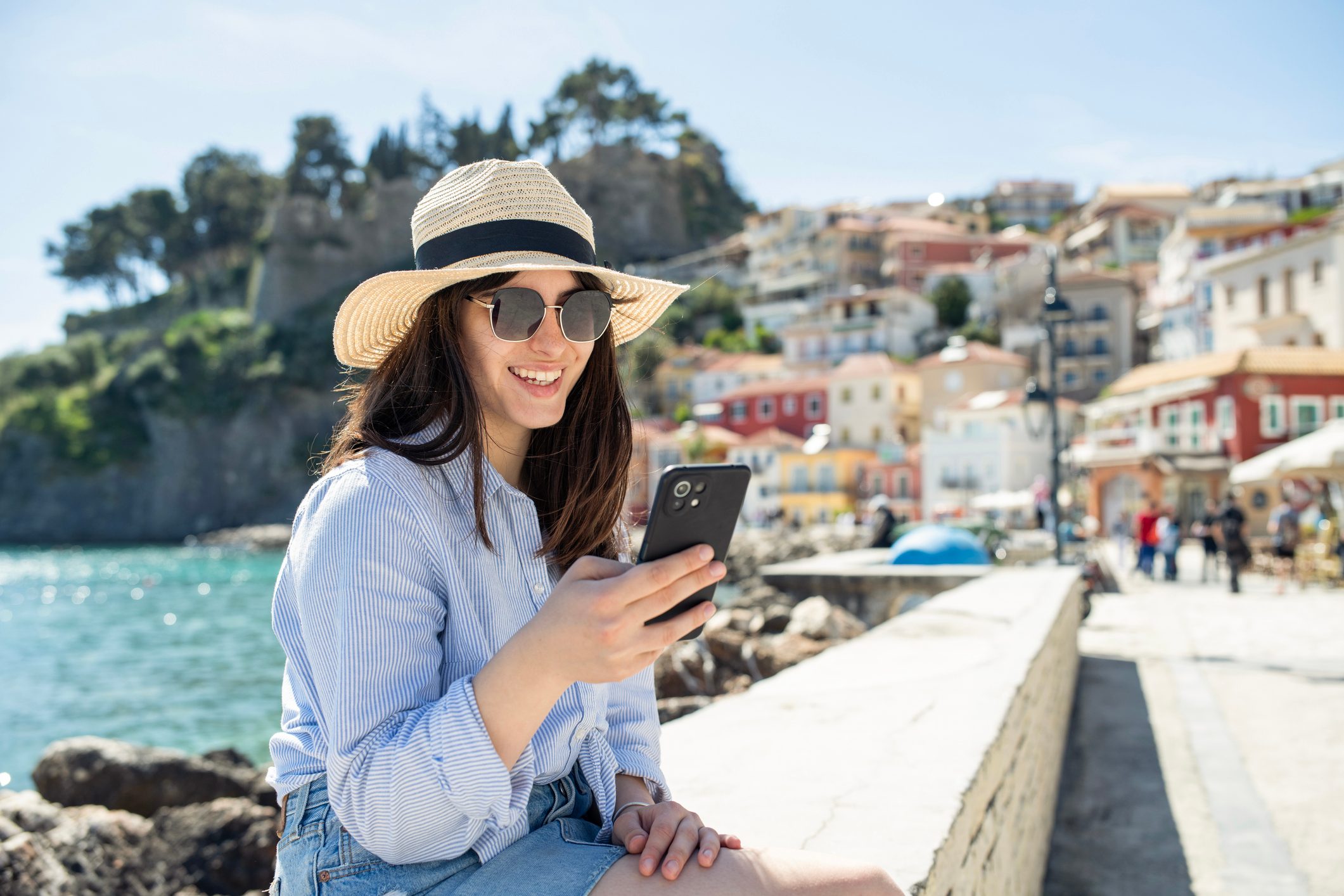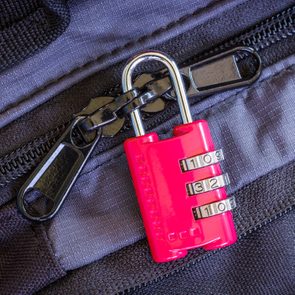Apple revealed an exciting upcoming feature that will help you streamline your next trip. But is it safe to use? Here's what you should know.

Apple Is Introducing a New Feature That Makes It Easier Than Ever to Travel—But Should You Use It?

Tech-savvy jet-setters already know how much of an asset a smartphone can be when traveling. Receiving real-time itinerary updates directly from the airline, tracking luggage and storing boarding passes right on your device are just a few ways your phone can make flying a bit less stressful—and it’s about to get even better for iPhone users.
Read on to find out what the new iPhone feature is, when you can start using it and its pros and cons, according to a cybersecurity expert.
Get Reader’s Digest’s Read Up newsletter for more travel, tech, cleaning, humor and fun facts all week long.
What new feature is Apple releasing?

Soon, U.S. travelers will be able to create a digital ID in Apple Wallet using their passport as part of a TSA-approved program. Apple announced this new feature at its recent Worldwide Developers Conference earlier this month. It’s part of the iOS 26 rollout, which is coming to iPhones sometime this fall (likely in September, in keeping with Apple’s usual release schedule) and will enhance the digital ID feature available in Apple Wallet.
The digital ID feature isn’t new, and residents of nine U.S. states (at the time of publication) can already use it to upload their driver’s licenses to Apple Wallet. With iOS 26, any U.S. citizen with an iPhone can create a digital ID with their passport.
This TSA-approved program effectively allows you to digitize your U.S. passport by simply scanning it with your iPhone camera and then verifying it using Face ID or Touch ID. Currently, this is slated to be available only in the U.S., but Apple is working with authorities in Europe and Asia to roll out the feature in other countries in the future.
The pros of uploading your passport to Apple Wallet
The primary benefit of digitizing your passport using your iPhone is simple convenience.
- Eliminates the need for an ID. Apple Wallet has all but eliminated the need to fumble around with paper flight tickets. Soon, with the iOS 26 digital ID update, you won’t have to pull out a physical passport when passing through airport security checkpoints—at least for domestic travel.
- Acts as a Real ID. More specifically, uploading one’s passport to Apple ID is a workaround for travelers who don’t yet have a Real ID, which after many delays, officially became a requirement for travel in May. Even if you do have a driver’s license with Real ID, uploading your passport can still be useful if your state driver’s license isn’t compatible with the Apple Wallet digital ID feature.
The cons of uploading your passport to Apple Wallet
There are some major limitations with the Apple Wallet digital ID feature, however.
- Not recognized internationally. Most important, your digitized passport is only valid for use at TSA checkpoints in the United States. Apple’s digital passport will not replace your physical passport for international border crossings, including re-entry into the country.
- Carries potential security risks. As with anything concerning personal documents, travelers must consider the trade-off between convenience and privacy. Uploading something like a passport to your Apple Wallet poses a higher potential security risk than simply uploading your boarding pass.
- Introduces privacy concerns. Some may be hesitant to use the new digital ID feature because of concerns of tracking by travel companies and government authorities. It’s no secret that companies gather all sorts of information about us, which sometimes gets compromised or sold. This recently happened when major U.S. airlines sold customers’ flight records to the Department of Homeland Security, as revealed by a recent report by 404 Media.
How to protect your personal information
The good news is that Apple employs robust on-device security, and it would take a lot for a criminal to compromise your iPhone. “Apple Wallet uses device-based encryption and Secure Enclave, which significantly reduces the risk of unauthorized access,” says Gregory Moody, PhD, a professor of information systems at the University of Nevada, Las Vegas and the director of the university’s graduate-level cybersecurity program.
However, he reminds travelers that, “while Apple has a strong record of on-device privacy controls, uploading a passport introduces a new attack surface.” Because of this, Moody advises iPhone owners to “enable features like Face ID and ensure iCloud backup is disabled for sensitive ID documents, if possible.”
Properly securing your device will make it more difficult for cybercriminals to gain access to your information, especially if your iPhone is lost or stolen. But in the event that it does go missing, you can lock or erase your device remotely via the “Find My” app.
As for tracking concerns, as far as the government is concerned, it doesn’t really matter whether you’re using your passport, Real ID or Apple Wallet digital ID. The authorities are going to know when you pass through a TSA checkpoint.
In short, while creating an Apple Wallet digital ID using your passport does introduce a new attack surface for cybercriminals, Apple’s security, the iPhone’s privacy features and common sense precautions should keep your data safe. Furthermore, if data brokers and government authorities are your primary concerns, there’s no compelling reason to sacrifice convenience for privacy by not uploading your passport to your iPhone.
Other ways to make getting through airport security more seamless
Uploading your passport to your iPhone can streamline domestic travel, but there are other tools to make those airport lines move a bit more quickly.
- TSA PreCheck. This official TSA “pre-screening” program allows approved travelers to move more quickly through airport security. With TSA PreCheck, you don’t have to take off your shoes or remove your electronics and any approved liquids from your carry-on luggage.
- Global Entry. This program works similarly to TSA PreCheck, streamlining re-entry into the U.S. for American citizens returning from abroad. Be aware that both programs have their own approval criteria and application fees and must be renewed every five years.
- Mobile Passport Control (MPC). This alternative to Global Entry is a free app offered by U.S. Customs and Border Protection. It allows eligible U.S. citizens and Canadian visitors to upload their passport and trip data upon landing in the U.S., which can greatly shorten wait times at U.S. Customs checkpoints.
- CLEAR Plus. CLEAR Plus uses facial recognition to allow you to skip the standard TSA ID check-in. CLEAR Plus is currently supported at more than 40 airports around the U.S. Some public venues, such as sports stadiums, also offer a faster check-in process via CLEAR. It requires a paid membership and doesn’t give you the benefits of TSA PreCheck when it comes to getting through airport security, but it prevents you from having to dig out your ID and lets you skip the ID check-in line at airports with CLEAR lanes. It works in conjunction with TSA PreCheck, as well.
Moody notes that for the smoothest airport experience, jet-setters should consider combining TSA PreCheck with CLEAR. “For frequent travelers, combining CLEAR’s biometric ID with TSA PreCheck can dramatically cut security wait times.”
RELATED:
- The TSA Issued a Warning About This Popular Device in Airports—Here’s What to Know
- This Common Gadget Is Banned in Checked Luggage—Here’s What You Need to Know
- This iPhone Hack Makes Converting Currency Easier Than Ever
About the expert
|
Why trust us
Reader’s Digest has published hundreds of articles on personal technology, arming readers with the knowledge to protect themselves against cybersecurity threats and internet scams as well as revealing the best tips, tricks and shortcuts for computers, cellphones, apps, texting, social media and more. We rely on credentialed experts with personal experience and know-how as well as primary sources including tech companies, professional organizations and academic institutions. We verify all facts and data and revisit them over time to ensure they remain accurate and up to date. Read more about our team, our contributors and our editorial policies.
Sources:
- Gregory Moody, PhD, professor of information systems at the University of Nevada, Las Vegas; email interview, June 2025
- Apple: “Apple services deliver powerful features and intelligent updates to users this fall”
- 404 Media: “Airlines Don’t Want You to Know They Sold Your Flight Data to DHS”
- U.S. Customs and Border Protection: “Mobile Passport Control (MPC)”
- CLEAR: “What is CLEAR+—and where can I use it?”























